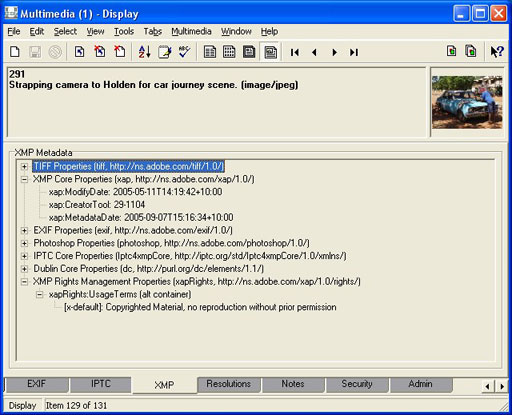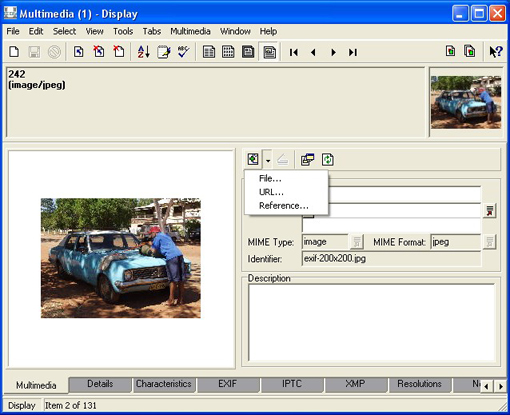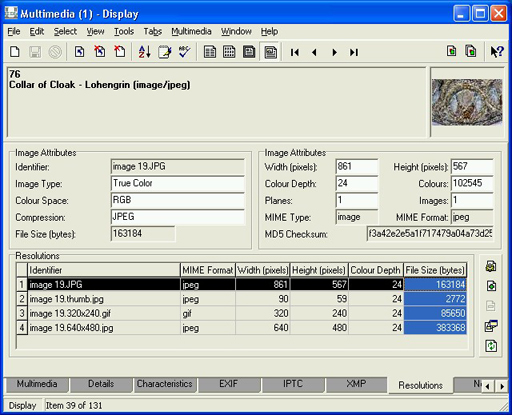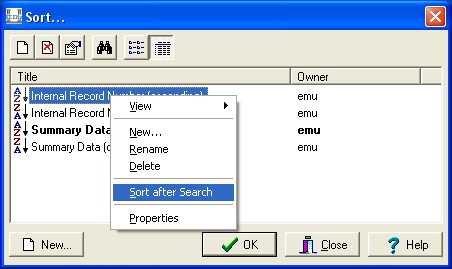Release Date: 29 March 2007
Requirements
- Windows 2000, XP, 2003, Microsoft Windows Services for UNIX (version 3.5)
- Texpress 8.1.008 or later
- TexAPI 3.1.010 or later
Updates / New Features
- New Conservation module: A new version of the Conservation module has been incorporated with the standard EMu release. A
 design document was developed in consultation with the user base and adapted to produce the new version of the module (see
design document was developed in consultation with the user base and adapted to produce the new version of the module (see  screenshots and commentary for details of changes to the module). The new module is backward compatible with the previous version, allowing institutions to stay with the old version or upgrade to the new one. Any data in an existing Conservation module is preserved in the new version. When enabling the new module institutions need to decide whether to allow multiple objects to be associated with a conservation event or only a single object. Tab switching will need to be adjusted appropriately. Please see the upgrade notes for complete details.
screenshots and commentary for details of changes to the module). The new module is backward compatible with the previous version, allowing institutions to stay with the old version or upgrade to the new one. Any data in an existing Conservation module is preserved in the new version. When enabling the new module institutions need to decide whether to allow multiple objects to be associated with a conservation event or only a single object. Tab switching will need to be adjusted appropriately. Please see the upgrade notes for complete details. - ImageMagick Libraries: To provide up-to-date support for emerging image standards (e.g. JPEG 2000) and also to extend the image formats available in EMu, the current image display libraries have been replaced with the open source
 ImageMagick libraries. The new libraries support over 100 image file formats, allowing the Multimedia Repository to store and interpret more image formats than previously possible. In particular, support for JPEG 2000 is now available. EMu is configured to handle a subset of the available formats by default, namely:
ImageMagick libraries. The new libraries support over 100 image file formats, allowing the Multimedia Repository to store and interpret more image formats than previously possible. In particular, support for JPEG 2000 is now available. EMu is configured to handle a subset of the available formats by default, namely:
- BMP - Microsoft Windows Bitmap Image
- DCX - ZSoft IBM PC multi-page Paintbrush
- GIF - CompuServe Graphics Interchange Format
- JP2 - JPEG 2000
- JPEG - Joint Photographic Experts Group
- PCD - Photo CD
- PCX - ZSoft IBM PC Paintbrush
- PNG - Portable Network Graphics
- TGA - Truevision Targa Image
- TIFF - Tagged Image File Format
EMu will also automatically include any image formats registered by applications installed on your computer. Two new registry entries provide control over which formats are used within an institution:
User|user|Setting|Multimedia|Images|Include|format;...
Group|group|Setting|Multimedia|Images|Include|format;...
Group|Default|Setting|Multimedia|Images|Include|format;...
System|Setting|Multimedia|Images|Include|format;...
and
User|user|Setting|Multimedia|Images|Exclude|format;...
Group|group|Setting|Multimedia|Images|Exclude|format;...
Group|Default|Setting|Multimedia|Images|Exclude|format;...
System|Setting|Multimedia|Images|Exclude|format;...
where:
format is the image format to include/exclude (see ImageMagick formats for a complete list of format values).
The Include entry is used to add image formats that are supported within your institution, while the Exclude entry allows formats to be removed from the standard list. For more information on these registry entries see ![]() Registry support for multimedia and metadata.
Registry support for multimedia and metadata.
- Audio and Video support: The audio and video libraries used by EMu have been replaced with new libraries that provide support for a larger range of formats. The supported formats are:
- Audio formats:
- AIFF - Audio Interchange File Format
- AU - Audio File Format
- MIDI - Musical Instrument Digital Interface
- MP3 - MPEG Audio Stream, Layer III
- RMI - MIDI in RIFF File Format
- SND - Sound File Format
- WAV - Waveform Audio
- WMA - Windows Media Audio File
- Video formats:
- ASF - Advanced Streaming Format
- AVI - Audio Video Interleave File
- M1V - MPEG-1 Video File
- M2V - MPEG-2 Video File
- MOD - JVC Everio GZ-MG20U Digital Video File
- MPEG - MPEG 1 System Stream
- WMV - Windows Media File
- Audio formats:
When EMu is invoked it detects all audio and video formats registered with Windows and makes them available. If an institution wants to limit the formats listed, Exclude registry entries may be used:
User|user|Setting|Multimedia|Audio|Exclude|format;...
Group|group|Setting|Multimedia|Audio|Exclude|format;...
Group|Default|Setting|Multimedia|Audio|Exclude|format;...
System|Setting|Multimedia|Audio|Exclude|format;...
and
User|user|Setting|Multimedia|Video|Exclude|format;...
Group|group|Setting|Multimedia|Video|Exclude|format;...
Group|Default|Setting|Multimedia|Video|Exclude|format;...
System|Setting|Multimedia|Video|Exclude|format;...
where:
format is the audio or video format to exclude.
- Metadata Support: The Multimedia module has been extended to provide support for the following metadata standards:
- EXIF - Exchangeable Image File Format (Version 2.2, April 2002)
- IPTC - International Press Telecommunications Council (IIM Version 4.1, July 1999)
- XMP - Extensible Metadata Platform (Revision September 2005)
The Multimedia module contains three new tabs (EXIF, IPTC andXMP) that hold the metadata for each of these standards. The metadata is extracted and stored in the multimedia record, making it available for searching and reporting. Metadata is extracted from the following file formats:
|
Standard |
Formats supported |
||
|
EXIF |
JPEG, TIFF |
||
|
IPTC |
JPEG, TIFF, PICT, PS, PSD |
||
|
XMP |
JPEG, TIFF |
The image below shows extracted XMP metadata:

The Update resources tool (Multimedia->Update Resource) has been extended to extract metadata from the master image and populate the new metadata tabs. Metadata is also extracted whenever an image is added to the system.
- Embed metadata in image derivatives: Where a master image contains metadata EMu can copy part or all of the metadata into derived images. Registry entries determine what is copied. The format of the entry is:
User|user|Setting|Multimedia|Metadata|Embed|type|format|tag;...
Group|group|Setting|Multimedia|Metadata|Embed|type|format|tag;...
Group|Default|Setting|Multimedia|Metadata|Embed|type|format|tag;...
System|Setting|Multimedia|Metadata|Embed|type|format|tag;...
where:
type is the type of metadata to embed. Allowable values are EXIF, IPTC or XMP.
format defines the image format for which the metadata will be embedded. A format of Default defines an entry for all image derivatives, an entry of JPEG or any other image type limits the entry to derivatives of the specified type, while an entry of width:height:format further limits the entry to a particular derivative size and type. The tag list depends on the metadata type selected. The list indicates what properties should be embedded in the derivative.
The Generate resolution tool (Multimedia->Generate Resolution) has been extended to embed metadata in all derived images based on the registry entry defined above. If the registry entry is not set, no metadata is embedded. For more information on these registry entries see ![]() Registry support for multimedia and metadata
Registry support for multimedia and metadata
- Extract metadata into fields in Multimedia repository: Metadata properties can be extracted and placed into fields in the Multimedia repository. The properties to be extracted and the columns into which the values are to be placed are controlled by registry entries. The format of the entry is:
User|user|Setting|Multimedia|Metadata|Extract|type|colname|tag;...
Group|group|Setting|Multimedia|Metadata|Extract|type|colname|tag;...
Group|Default|Setting|Multimedia|Metadata|Extract|type|colname|tag;...
System|Setting|Multimedia|Metadata|Extract|type|colname|tag;...
where:
type is the type of metadata to extract. Allowable values are EXIF, IPTC or XMP.
colname is the name of the column into which the values are to be placed. The tag list depends on the metadata type selected. The list indicates what properties should be extracted for inclusion in the Multimedia repository.
For more information on these registry entries see ![]() Registry support for multimedia and metadata.
Registry support for multimedia and metadata.
- Media selection dialogue box: The form displayed when inserting media into the Multimedia module has been replaced with a contemporary Windows Explorer dialogue box, allowing a preview of media (images, audio, video). The preview checkbox setting is now preserved between sessions:

Separate dialogue boxes have been designed for adding URL and Reference type media. When adding new media the media type is selected from a button drop list:

- Resolutions Tab: The Resolutions tab in the Multimedia module has been changed to include new properties. These changes include:
- Addition of MD5 Checksum field for all media (useful for checking validity of media).
- Addition of Colour Space field (RGB or CMYK).
- Addition of Image Type field (Monochrome, Greyscale, True Color or Palette).
- Addition of Image Resolution field (Pixels per Inch).
- Changed Bits per Pixel field to Colour Depth (number of bits required to reflect accurately all colours).
- Compression field now contains correct method of compression.
- Number of unique Colours in an image is now calculated correctly.

- Characteristics Tab: Properties from the master image are now extracted automatically and added to fields in the Characteristics tab in the Multimedia module. The following fields are populated:
- Width
- Height
- MD5 Checksum
- File Size
- Image Resolution
- Colour Depth
- Drag and Drop Media and URLs: When adding media to the Multimedia repository it is now possible to drag media files (documents, images, audio, video, etc.) from Windows Explorer and drop them on the media display area on the Multimedia tab. Using this mechanism the media selection dialogue box is no longer required to add media. It is also possible to drag a URL from your web browser and drop it on the media display area.
- User based Dictionary: Any user based dictionary, that is, words added to the dictionary as part of the spell checking process, is now stored under the Windows APP_DATA area. The dictionary was previously kept under the Windows LOCALAPP_DATA area (typically C:\Documents and Settings\username\Local Settings\Application Data\KESoftware). Windows does not make files in the LOCALAPP_DATA area available when Windows roaming accounts are implemented. The APP_DATA area (typically C:\Documents and Settings\username\Application Data\KESoftware) is available to a user on all machines in which they log in. The change means that all words added to the dictionary will now be available regardless of the machine used. In a Citrix environment the same dictionary is now available regardless of the session you receive.
When the EMu 3.2.03 Windows client is installed the old user dictionary is not copied to the new location (due to possible security restrictions). If you want to continue with your current user based dictionary, please move all files that end with .udt from the LOCALAPP_DATA area to the APP_DATA area. The exact location of these two areas can be determined by looking up AppData and LocalAppData under \HKEY_CURRENT_USER\Software\Microsoft\Windows\CurrentVersion\Explorer\Shell Folders in the Windows registry.
- Automatic sorting of results: A user can now nominate a sort criteria to be run once a search completes. The sort commences immediately after the query completes and can be cancelled if required. The sort is selected from the list of sorts defined for a given user (Tools->Sort Results). The selected sort is highlighted in bold. The entry can be toggled to turn off a given sort:

- Local lookup list defaults: Institutions can now replace the standard system lookup list default values files (stored in luts/default) with their own local instances (stored in local/luts/default). Local default files must have the same name as the standard system default file.
Issues Resolved
| Issue | Resolution | |
|---|---|---|
|
The Web Site Bibliography record type does not provide a button to allow the entered URL to be launched. |
A button has been added to the Web Site Identifier field to launch the entered URL in a web browser. |
|
|
The Multimedia repository does not provide support for 16 bit image formats. |
The new ImageMagick libraries provide full support for 16 bit image formats. |
|
|
The Multimedia repository does not provide support for images that use a CMYK colour space. |
The new ImageMagick libraries provide full support for CMYK colour space. |
|
|
When generating a new resolution or resizing an existing image, the quality of the derivative is significantly less than the original. |
ImageMagick uses an adaptive resizing technique that provides superior results to the previous image libraries. |
|
|
The Compression value on the Resolutions tab not only contains compression information, it also contains colour space (RGB/CMYK), image type (Monochrome, Greyscale, True Color, Palette) and interlace information. |
New fields have been added for storing the colour space and image type. The Compression now reflects the compression type used to store the image. |
|
|
The Colours value (number of unique colours stored in an image) is not accurate as it only reflects the bits per pixel value. |
The correct value for Colours is now stored. |
|
|
When switching between prompt languages (e.g. English to French) the field level help window may become visible when it is hidden. |
The field level help screen now remains hidden when changing prompt languages. |
|
|
The modified time on a server-side report file may be one hour out when daylight savings is in force. |
The correct modified time is now displayed. |
|
|
When changing the Command Centre to show images only, the letters H and F may be displayed next to the Field Help and Help buttons respectively. |
The letters are no longer shown. |
|
|
When using the Import facility empty table columns are not included in searches for attachment record, while empty atomic columns are included. This means that attachment searches do not discriminate between empty or filled tables. |
Attachment searches now include explicit checks for empty tables when the column is empty in the data provided. |
|
|
It is possible to select the View Attached -> Selected Records command under the Edit menu when on a reverse reference field. An error indicates correctly that attachments cannot be viewed. |
The View Attached -> Selected Records command is no longer available when on a reverse reference column. |
|
|
Clearing a row in a double nested grid may result in an incorrect row of data being removed from the grid. In general the first deletion works correctly, however a subsequent delete may be incorrect. |
Deleting data from a double nested grid now removes the correct data for the first and all subsequent deletions. |
|
|
Switching from EMu to another Windows application (via ALT+TAB) and then returning to EMu may result in the active form being hidden behind a disabled form. You cannot select the active form as the disabled form cannot be moved. |
The active form is now always displayed as the top level form when EMu is activated. |
|
|
If a grid is part of a nested form construct and the data in the grid is read-only, an incorrect number of rows may be shown. |
The correct number of rows is displayed for read-only grids that are part of a nested form construct. |
|
|
If a combo box is part of a read-only hierarchy of values and leading letters are used to locate a value, the supplied list is not updated every time a new key is entered. |
The list of values for a read-only combo box is now updated after every key stroke. |
|
|
If data is entered into a field that supports auto fill and the insertion or edit is cancelled without exiting the field, an Access Violation may occur. |
Cancelling an edit or insertion while on an auto fill field no longer produces an Access Violation. |
|
|
Where an IRN range is set on a module and the Import facility is used to update records (by supplying the IRN), an IRN out of range error may be produced. The error should only be displayed when inserting records. |
When a record is updated by the Import facility the IRN out of range check is no longer conducted. |
|
|
Importing new records into the taxonomy module may result in an Access Violation. |
New records can now be imported into the Taxonomy module. |
|
|
Entering certain latitude and longitude values may result in a rounding error allowing the seconds value to be 60. |
The latitude and longitude rounding code now propagates full components to the next level, so 60 seconds increments the minutes value and sets seconds to zero. |
|
|
When using the "Whole Words Only" option to perform a global replace, the text located may be missing the search text. |
The search text is always replaced when the "Whole Words Only" option is used in a global replace. |
|
|
If the "Save Last Size" EMu option is enabled to allow forms to be shown with the last size used, the field level help widow will not display with the correct size. |
The correct size is now displayed. |
|
|
If a module has "Show Shortcuts" enabled and the Import facility is used to add records to the module, you may get an Access Violation. |
Importing records with "Show Shortcuts" enabled now functions correctly. |
|
|
Creating records using the Import facility where all levels of a hierarchy are empty and auto fill is enabled may result in a "List out of bounds" error. |
The "List out of bounds" error is no longer displayed. |
Upgrade Notes
The upgrade from KE EMu Version 3.2.02 to KE EMu 3.2.03 involves a number of steps. Please follow the instructions below carefully.
Do not skip any steps under any circumstances.
Before proceeding with the update please ensure that a complete backup of the KE EMu server exists and is restorable.
- Install KE Texpress 8.1.008 or greater.
- Install KE TexAPI 3.1.010 or greater.
- Log in as emu.
- The following steps need to be repeated for each client installed on the KE EMu server.
Please ensure that no one is using the system while the upgrade is underway. - Enter client client
- Enter upgrade-3-2-03
- If the client has the Conservation module installed (econservation), then the tab switching entries may need to be modified to enable the correct tabs. The tabs available are:
# Core Tabs
#
QryTasTab;QryMedTab;QrySecTab;QryAdmTab;
AllTasTab;AllMedTab;AllSecTab;AllAdmTab;
# Standard Notes Tabs
#
QryNotTab;
AllNotTab;
#
# ... or Attributed Notes Tabs
#
QryNteTab;
AllNteTab;
# Old Conservation Tabs
#
QryReqTab;QryAutTab;QryObjTab;QryFinTab;
AllReqTab;AllReq2Tab;AllAutTab;AllObjTab;AllFinTab;
#
# ... or New Conservation Tabs
#
QryDscTab;QryCndTab;QryProTab;QryTrtTab;QryAnyTab;QryAccTab;QryRecTab;
QryOthTab;QryObj2Tab;
AllDscTab;AllCndTab;AllProTab;AllTrtTab;AllAnyTab;AllAccTab;AllRecTab;AllOthTab;
# New Conservation - Many Objects to One Conservation Record
#
AllObj2Tab;
#
# ... or New Conservation - One Object to One Conservation Record
#
AllObj1Tab; - To adjust the tab switching locate the Group|Default|Table|econservation|Tabs|Default| registry entry and change the tab list to contain the entries required from the table above.
- Go back to instruction 5 to commence upgrading the next client, until all clients are complete.
EMu 3.2.03 does not require the new Windows client to be installed on every machine for network installations. Updating the network server will install all parts required to access the new image, video and audio libraries. For standalone installations a new client is required on each machine.
Updating existing Multimedia records
Many images already loaded into the Multimedia module may contain metadata. In order to populate the multimedia records with this data it is necessary to perform an update on all the media resources. For some institutions this update may take some time as it involves downloading each master image on the server to a local machine and examining it for metadata. Fortunately EMu provides a command that automates this process, the Update Resources command. The following sequence can be used to update all image media records:
- Install KE EMu 3.2.03 client on local machine (or network server for network based installations).
- Start up EMu and log in as a user authorised to edit multimedia records (typically emu).
- Open the Multimedia module.
- In the MIME Type field on the Multimedia tab enter image.
- Perform a search (File>Search) to retrieve all image records.
- Select all the records (Select>All Records in Results).
- Run the Update Resources tool (Multimedia>Update Resource>Selected Records).
- The update may take some time if it involves a large number of images. The registry entry:
System|Setting|Multimedia|Colours|Maximum Size
may be used to dramatically speed up the update time for large images. - Once the update is complete the metadata is accessible via the new EXIF, IPTC and XMP tabs.

